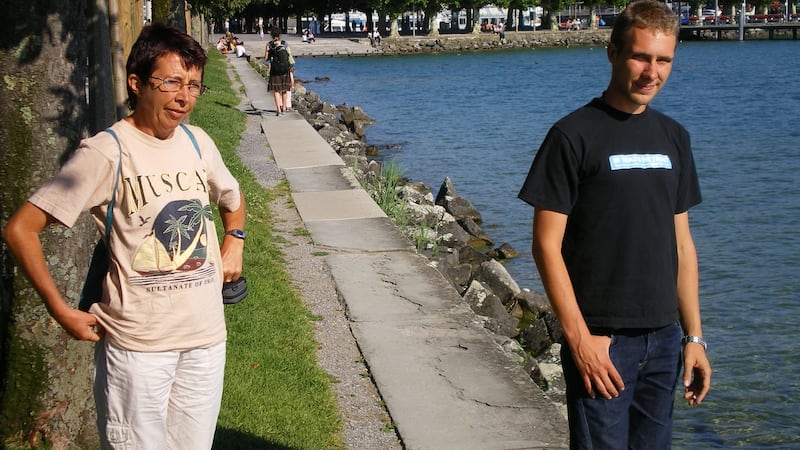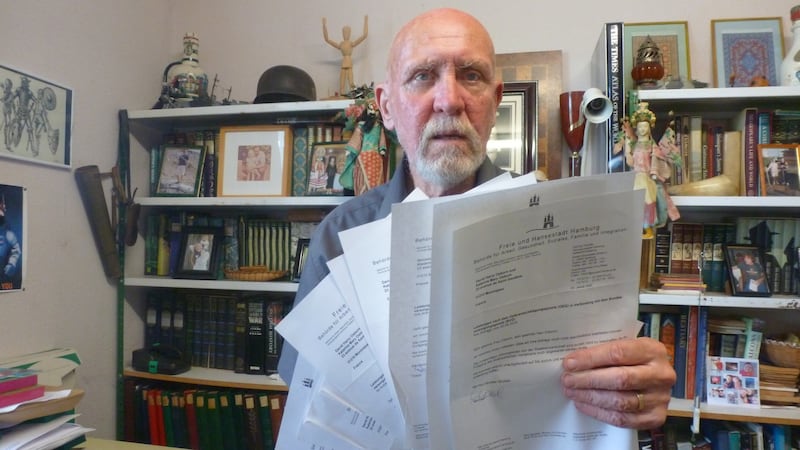The last trace of Martin Osborn’s third birthday party is a small, half-eaten cake sitting on the kitchen table, topped with a “3” candle.
Martin is in kindergarten and, before his mother Nicole collects him, she is hurrying to make coffee.
We’re in a south Hamburg suburb that ticks all the boxes: large semidetached red-brick houses, quiet streets lined with apple blossom trees and abandoned bobby cars and scooters scattered in driveways.

Nicole is a 34-year-old single mother – and a widow. Three years ago, on May 22th, 2019, her husband Oisín was shot dead, 10 days after he became a father.
Three years on, Nicole still doesn’t know why her emergency call ended as it did. Armed police officers in protective gear burst into their home, raced up the stairs and shot the 34-year-old man dead on the landing. “We live in a peaceful area, not a warzone, so I simply don’t understand why this happened,” says Nicole, a woman with long blonde hair and a strong, mournful gaze. “May 22nd is with me every day of the year.”
After a lonely period of mourning in the pandemic, the school teacher says she is beginning to accept her new life with her son. She fears it could all fall apart again, though, but doesn’t know when. Three years have passed, but the state prosecutor in Hamburg, Germany’s second-largest city, is still investigating, leaving Nicole and Oisín’s family in limbo.
Couch-surfing
Nicole laughs as she tells the story of how she met Oisín in 2008 – two language and travels nerds with online profiles. “It was a Couch-surfing platform,” she says, eyes shining.
Intrigued by his profile, she arranged to meet him and Nicole found herself completely at ease with this chatty, multilingual man: English father, Irish mother, raised in Spain and France, a promising career in engineering. “He was extremely open, friendly, a person you would like to be with, he had so many traditions and could see life as a French person, Spanish, British and Irish, of course,” says Nicole, recalling the Irish songs he sang for her.
“It felt like we were on the same wave, like two pieces of a puzzle. He said that everything just felt easy with me, that we could go down the road hand-in-hand.”
A quiet wedding came in 2013 and, in 2019, their first baby. After a difficult birth, baby Martin spent a week in intensive care with an infection before going home with his exhausted parents.
Through a fog of fatigue, Nicole remembers Oisín was increasingly agitated, but put it down to a painful allergic reaction he had suffered to hospital hand disinfectant. As the days at home passed, the happy father-to-be who had painted a big rainbow on the nursery wall – as his father had done for him – was gone. Instead, another Oisín paced the house, covered up mirrors and, Nicole remembers, promised to protect her and Martin “from everything and everyone, even evil spirits”.
On the morning of May 22nd, something snapped.
The last time she saw her husband alive, half-dressed and deeply distressed, he was wearing a saucepan on his head. 'He said it was for protection,' remembers Nicole
Nicole woke up to find Oisín in a frantic state, running up and down the stairs. He had brought up kitchen appliances to the bedroom; laid on the bed she saw every knife in the house, including steak knives.
That triggered a protective instinct in the young mother. She dialled 112 and the operator, hearing “knife”, put her through to police.
Sirens
Minutes later, shortly after 10am, Nicole remembers hearing sirens and voices outside. The last time she saw her husband alive, half-dressed and deeply distressed, he was wearing a saucepan on his head. “He said it was for protection,” remembers Nicole, scratching beneath her nose and slowing down. “I said I loved him and he stepped out of the room. Then I heard what I thought were fireworks.”

What happened next is the subject of an ongoing investigation by Hamburg’s state prosecutor and cannot be reported in detail. After a large number of police officers in full riot gear surrounded the Osborn house, Nicole thinks they gained entry through the patio door at the rear of the house, and moved straight ahead to the ground floor hall and staircase to the right of the front door.
A police statement at the time said officers were confronted on the stairs with an man carrying “what appeared to be a knife” – a matter of close investigation now – and opened fire. Nicole says she heard at least four bangs, possibly six.
She didn't realise he was dead until later, outside in a police car, when an officer referred to Oisín in the past tense
We leave the kitchen for the hallway, where Nicole shows me the narrow, enclosed stairwell to the first floor. Even in the daytime it is a gloomy space; to get upstairs you need to make a right turn – twice.
Upstairs, she points out the spot on the ground where she saw Oisín lying, tucked up in a baby position. Escorted past, she saw no blood and didn’t realise he was dead until later, outside in a police car, when an officer referred to Oisín in the past tense.
Mood swings
David and Katrina Osborn had been worried about their son since Martin’s birth because of his mood swings, from euphoric to agitated. When David tried to call Oisín on May 22nd, an unfamiliar voice – a family friend – answered the phone.
“He said, ‘I am sorry, your son is dead,’ that’s how I heard,” says David Osborn, on a phone call with his wife from France, where they live.
The couple hurried to Hamburg and were met by an Irish embassy official and a Garda sergeant based in the Hague, before being questioned separately by the police.
As weeks turned into months, they grew frustrated by what they viewed as stonewalling from Hamburg and hired a German criminal lawyer.

Like Nicole, Katrina and David Osborn are anxious to remember Oisín as the bright, capable man he was – fluent in five languages, an inventive engineer who was going places in his career at Airbus and excited about being a father. He had no criminal record, no history of mental illness or domestic assault. Yet, one call from his anxious wife ended with him dead in their home.
The autopsy revealed no alcohol, drugs or other stimulants in his blood. Apart from that, his mother Katrina says, they have few answers, just guesses. “It’s not uncommon for people under extreme pressure to have an anxiety attack,” says Katrina, who was born in Abbeyleix, but grew up in Castletroy, Co Limerick.
Three years on, Oisín’s parents want to know why police shot their son multiple times, and why no non-fatal means were tried to control him. “We have no explanation for why the Hamburg police acted like something out of a US swat team,” says David.
Complex investigation
A Hamburg police spokesman told The Irish Times he was unable to comment on the ongoing investigation. A spokeswoman for the state prosecutor said that the case was in its final stages after a complex investigation which had required time. “In such cases, this is not usual and is the basis of a correct processing of a case,” the spokeswoman added.
Nicole Osborn’s lawyer, Claudia Krüger, says the case has been complicated, requiring reports from various experts. “But even I am unhappy with the pace of the investigation and would have expected it to proceed much quicker,” she said.
In his high-ceilinged Berlin office, Elvis Jochmann – a criminal lawyer engaged by David and Katrina Osborne – says that three years is an unusually long time for a criminal investigation in Germany. Every few months he contacts the Hamburg prosecutor for an update, but gets an identical letter in response.
The Osborn family and their lawyers knows the odds are stacked against them ever finding out what happened to Oisín. In Germany, 54.8 per cent of criminal investigations do not proceed to trial, according to a study from 2015. If the main suspect is a police officer, that number rises to 97.7 per cent. Even if a case against a police officer goes to trial, only a tiny number end in prosecution.
For Claudia Krüger, these numbers reflect the nature of police work, in particular how often officers find themselves in dangerous situations where they have to make quick decisions and act in self-defence. Like anyone else, she says, police officers are presumed innocent unless proven otherwise. But fellow lawyer Elvis Jochmann says the numbers also reflect a system that favours police officers.
“The problem is that they know how a case is investigated and also what is expected when they testify,” said Mr Jochmann. “They know how to frame their actions as self-defence, regardless.”
Unlike other countries, German federal states have no separate bodies for investigating complaints against police officers
He is not alone in his concern. A major study of German police violence, to be presented in September, estimates that, for every criminal complaint against a German police officer for violent behaviour, five more go unreported.
Even if a complaint is made, German criminologist Tobias Singelnstein, the study’s lead researcher, says “structural flaws” in the criminal justice system make it very unlikely the complaint will go any further.
Complaints
Unlike other countries, German federal states have no separate bodies for investigating complaints against police officers. Instead, the criminal police investigate such cases themselves, even questioning colleagues who are suspects, before the case is passed to the state prosecutor.
Prof Singelnstein, professor for criminal law at Frankfurt’s Goethe University, says this creates a problem in practice because police are part of the criminal justice system and state prosecutors work with them every day and depend on them. “For state prosecutors, police officers are not normal suspects,” he said, “and, perhaps unconsciously, they take a different approach with them”.
Sometimes in such cases, it falls to German courts to correct prosecutors. In 2018, a Berlin police officer was investigated for shooting dead an Iraqi man he claimed had threatened him with a knife. The prosecutor moved to drop the case, the dead man’s family took legal action and a Berlin court forced the case to be reopened, saying “the circumstances that led to the use of gun, and what could have justified it, have not been adequately explained”.
Hamburg police say they have just three cases of police using their service weapons in the last five years: 2017, 2019 and 2021. Hamburg’s state prosecutor says it has examined “numerous” complaints alleging police violence in the past decade and “isolated” cases where people died, but adds: “Statistics about this are not kept at the state prosecutor’s office.”
‘Bright new life’
In her Hamburg home, Nicole Osborn heads down the stairs, past photographs on the wall of her – alone – with her growing son. When Martin sees pictures of Oisín now, he doesn’t understand that this is the father he had for just 10 days.
“It’s painful for me to see how Martin runs to his friends’ fathers, hangs out of them and calls them ‘papa’,” she says.
In the living room she points out the new dining table and chairs they bought, the new wooden floor Oisín laid, and the green and yellow walls they painted together. It was part of a “bright new life” they planned, she says, before it was snuffed out in a hail of bullets.
Nicole says she has run through in her head every angle – even the police officers’ perspective called to a unfamiliar house with minimal information. Packing her bag to collect her son from the kindergarten, Nicole says quietly: “Oisín wasn’t himself that day. But is it normal, in a peaceful society, to use methods like that?”











